印度英文版介绍
- 格式:ppt
- 大小:3.99 MB
- 文档页数:21
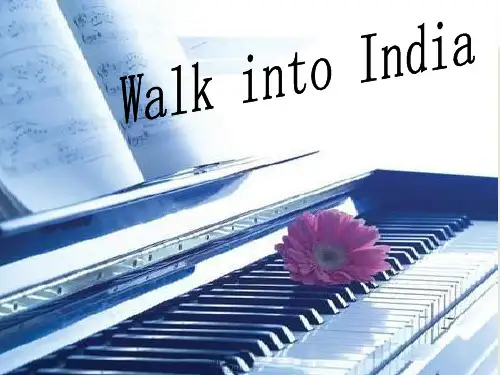
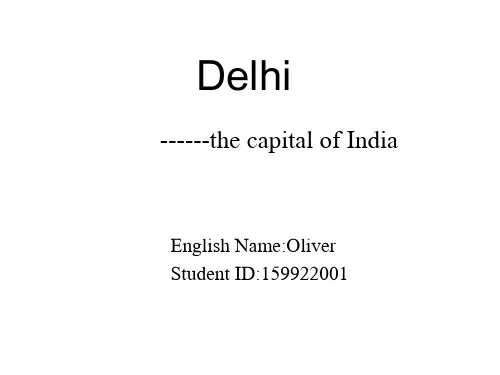
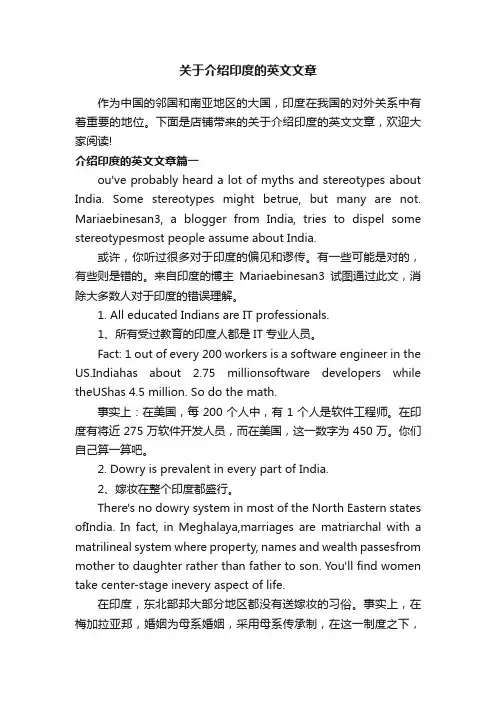
关于介绍印度的英文文章作为中国的邻国和南亚地区的大国,印度在我国的对外关系中有着重要的地位。
下面是店铺带来的关于介绍印度的英文文章,欢迎大家阅读!介绍印度的英文文章篇一ou've probably heard a lot of myths and stereotypes about India. Some stereotypes might betrue, but many are not. Mariaebinesan3, a blogger from India, tries to dispel some stereotypesmost people assume about India.或许,你听过很多对于印度的偏见和谬传。
有一些可能是对的,有些则是错的。
来自印度的博主Mariaebinesan3试图通过此文,消除大多数人对于印度的错误理解。
1. All educated Indians are IT professionals.1、所有受过教育的印度人都是IT专业人员。
Fact: 1 out of every 200 workers is a software engineer in the US.Indiahas about 2.75 millionsoftware developers while theUShas 4.5 million. So do the math.事实上:在美国,每200个人中,有1个人是软件工程师。
在印度有将近275万软件开发人员,而在美国,这一数字为450万。
你们自己算一算吧。
2. Dowry is prevalent in every part of India.2、嫁妆在整个印度都盛行。
There's no dowry system in most of the North Eastern states ofIndia. In fact, in Meghalaya,marriages are matriarchal with a matrilineal system where property, names and wealth passesfrom mother to daughter rather than father to son. You'll find women take center-stage inevery aspect of life.在印度,东北部邦大部分地区都没有送嫁妆的习俗。

More than 1 billion people live in India, a country in southern Asia. Only China has more people. The people of India speak more than 100 different languages.Facts About IndiaOfficial name Republic of IndiaCapital New DelhiPopulation 1,150,000,000 peopleRank among countries inpopulation2ndMajor cities Kolkata (Calcutta), Delhi, Mumbai (Bombay)Area 1,220,000 square miles3,170,000 square kilometersRank among countries in area 7thHighest point Kanchenjunga28,209 feet/8,598 metersCurrency Indian rupeeCITIES AND VILLAGESKolkata (also spelled Calcutta) is India’s largest city. Mumbai (also called Bombay) is the country’s most populated urban area. They rank among the world’s largest cities, too. New Delhi is the capital of India.More than 16 million people live in or near the port city of Mumbai. Mumbai is a center of trade and the center of India’s movie business. India makes about 800 movies a year, more than any other country in the world.In spite of its large cities, India is primarily a country of villages. Most of India’s people make their living by farming. Many of them are extremely poor.More and more people are moving from rural areas of India to cities. They hope to find better-paying jobs in the cities. India’s cities ha ve become very crowded as a result.A SUBCONTINENTIndia is shaped like a triangle. It juts out from the bottom of Asia into the Indian Ocean. India is sometimes called a subcontinent. Is thisbecause India is big? Not really. Six countries—including Russia, Canada, and the United States—are bigger.India is a subcontinent because it is cut off from the rest of Asia. Mountains, jungles, and the Indian Ocean form barriers that make India a world apart—a subcontinent.India’s neighbors Pakistan and Bangladesh also form part of the Indian subcontinent. These lands were once part of India.A LAND OF CONTRASTSThe Indian subcontinent offers striking contrasts. The Himalayas, the world’s highest mountains, extend across northern India. Towns lie on the lower slopes, but few people live high in the mountains.South of the mountains stretch broad plains. Two great rivers, the Ganges and the Brahmaputra, flow through the plains. Tea grows on plantations to the east. The huge Thar Desert lies to the west.A vast plateau lies south of the plains. Much of this region is rocky. The climate of the plateau is extremely hot. Every summer, winds called monsoons drop heavy rain on India.JUNGLES AND WILDLIFEThe English language borrowed the word jungle from Hindi, the languag e spoken by most Indians. India’s jungles are home to many fascinating animals. Tigers, panthers, lions, cheetahs, snow leopards, monkeys, and elephants are all found in India. So is the poisonous cobra snake. India has many national parks and wildlife preserves where its animals can be seen.TAJ MAHALThe Taj Mahal in Agra, India, is considered one of the most beautiful buildings in the world. An emperor built it after the death of his young wife. She died in 1631. Her tomb is inside.The Taj Mahal is covered in white marble and set in a garden with pools of water. The garden represents paradise. The building is decorated with beautiful carvings and colored stones. Its color appears to change throughout the day as the sun moves across the sky.RELIGION IN INDIAHinduism and Buddhism, two of the world’s major religions, were born in India. So were the Jain and Sikh religions. Most of India’s people are Hindus. Muslims—followers of Islam—are second in number.Hindus worship in the many beautiful temples they have built in India. They also worship at home. Hindus worship all life. They do not kill animals, and they do not eat meat.Muslims also have built many beautiful buildings, including the Taj Mahal. Hindus and Muslims have not always gotten along. Muslim invaders brought Islam to India. For centuries, Muslims ruled a largely Hindu country.A BRITISH COLONYDuring the 1700s, Britain gained control of India. Many Indians began speaking English. British sports, such as cricket and badminton, became popular. But many British efforts to change Indian customs and traditions were far less popular.MAHATMA GANDHIMohandas K. Gandhi was a Hindu who led India to independence from Britain. Gandhi’s followers called him Mahatma, which means “great soul.”Gandhi taught people to work for independence without using violence. Thanks to his efforts, India gained its independence in 1947. Gandhi’s policy of nonviolence influenced many other people. In the United States, Martin Luther King, Jr., used Gandhi’s idea of nonviol ent protests to gain civil rights for black Americans.AFTER INDEPENDENCEWhen India gained its independence, it split apart. The parts of India that were primarily Muslim became the country of Pakistan. Pakistan was made up of two parts, one to the east of India and the other to the west. In 1971, East Pakistan became a separate country called Bangladesh.。
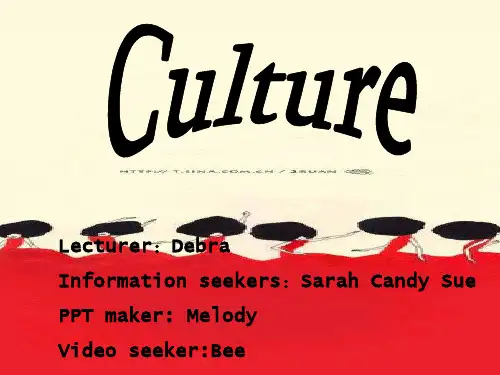
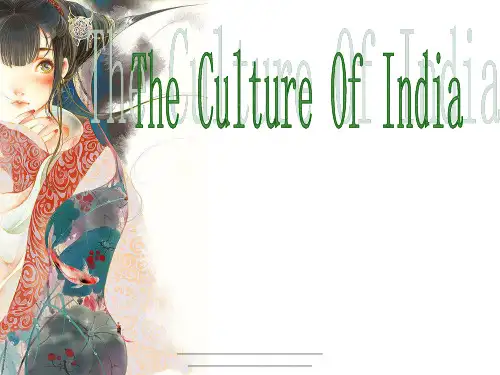
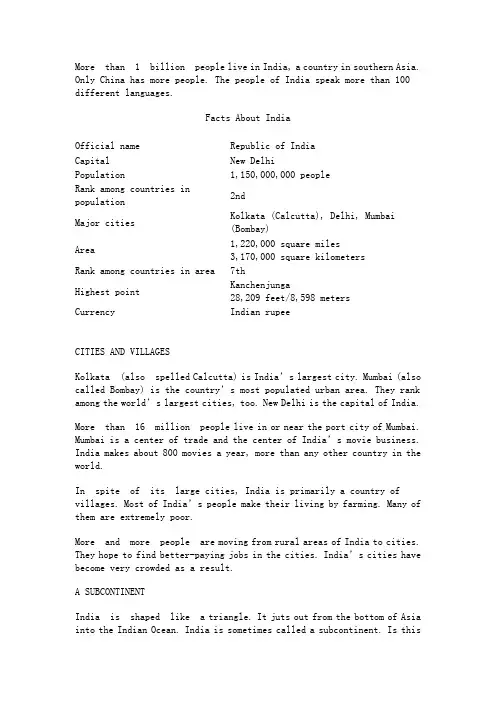
More than 1 billion people live in India, a country in southern Asia. Only China has more people. The people of India speak more than 100 different languages.Facts About IndiaOfficial name Republic of IndiaCapital New DelhiPopulation 1,150,000,000 peopleRank among countries inpopulation2ndMajor cities Kolkata (Calcutta), Delhi, Mumbai (Bombay)Area 1,220,000 square miles3,170,000 square kilometersRank among countries in area 7thHighest point Kanchenjunga28,209 feet/8,598 metersCurrency Indian rupeeCITIES AND VILLAGESKolkata (also spelled Calcutta) is India’s largest city. Mumbai (also called Bombay) is the country’s most populated urban area. They rank among the world’s largest cities, too. New Delhi is the capital of India.More than 16 million people live in or near the port city of Mumbai. Mumbai is a center of trade and the center of India’s movie business. India makes about 800 movies a year, more than any other country in the world.In spite of its large cities, India is primarily a country of villages. Most of India’s people make their living by farming. Many of them are extremely poor.More and more people are moving from rural areas of India to cities. They hope to find better-paying jobs in the cities. India’s cities ha ve become very crowded as a result.A SUBCONTINENTIndia is shaped like a triangle. It juts out from the bottom of Asia into the Indian Ocean. India is sometimes called a subcontinent. Is thisbecause India is big? Not really. Six countries—including Russia, Canada, and the United States—are bigger.India is a subcontinent because it is cut off from the rest of Asia. Mountains, jungles, and the Indian Ocean form barriers that make India a world apart—a subcontinent.India’s neighbors Pakistan and Bangladesh also form part of the Indian subcontinent. These lands were once part of India.A LAND OF CONTRASTSThe Indian subcontinent offers striking contrasts. The Himalayas, the world’s highest mountains, extend across northern India. Towns lie on the lower slopes, but few people live high in the mountains.South of the mountains stretch broad plains. Two great rivers, the Ganges and the Brahmaputra, flow through the plains. Tea grows on plantations to the east. The huge Thar Desert lies to the west.A vast plateau lies south of the plains. Much of this region is rocky. The climate of the plateau is extremely hot. Every summer, winds called monsoons drop heavy rain on India.JUNGLES AND WILDLIFEThe English language borrowed the word jungle from Hindi, the languag e spoken by most Indians. India’s jungles are home to many fascinating animals. Tigers, panthers, lions, cheetahs, snow leopards, monkeys, and elephants are all found in India. So is the poisonous cobra snake. India has many national parks and wildlife preserves where its animals can be seen.TAJ MAHALThe Taj Mahal in Agra, India, is considered one of the most beautiful buildings in the world. An emperor built it after the death of his young wife. She died in 1631. Her tomb is inside.The Taj Mahal is covered in white marble and set in a garden with pools of water. The garden represents paradise. The building is decorated with beautiful carvings and colored stones. Its color appears to change throughout the day as the sun moves across the sky.RELIGION IN INDIAHinduism and Buddhism, two of the world’s major religions, were born in India. So were the Jain and Sikh religions. Most of India’s people are Hindus. Muslims—followers of Islam—are second in number.Hindus worship in the many beautiful temples they have built in India. They also worship at home. Hindus worship all life. They do not kill animals, and they do not eat meat.Muslims also have built many beautiful buildings, including the Taj Mahal. Hindus and Muslims have not always gotten along. Muslim invaders brought Islam to India. For centuries, Muslims ruled a largely Hindu country.A BRITISH COLONYDuring the 1700s, Britain gained control of India. Many Indians began speaking English. British sports, such as cricket and badminton, became popular. But many British efforts to change Indian customs and traditions were far less popular.MAHATMA GANDHIMohandas K. Gandhi was a Hindu who led India to independence from Britain. Gandhi’s followers called him Mahatma, which means “great soul.”Gandhi taught people to work for independence without using violence. Thanks to his efforts, India gained its independence in 1947. Gandhi’s policy of nonviolence influenced many other people. In the United States, Martin Luther King, Jr., used Gandhi’s idea of nonviol ent protests to gain civil rights for black Americans.AFTER INDEPENDENCEWhen India gained its independence, it split apart. The parts of India that were primarily Muslim became the country of Pakistan. Pakistan was made up of two parts, one to the east of India and the other to the west. In 1971, East Pakistan became a separate country called Bangladesh.。

印度英文介绍作文带翻译英文:India is a land of diverse cultures, languages, and traditions. With a rich history spanning thousands of years, it's a country that never fails to fascinate both localsand visitors alike. From the bustling streets of Mumbai to the serene backwaters of Kerala, India offers akaleidoscope of experiences.One of the most striking aspects of India is its linguistic diversity. With over 22 officially recognized languages and countless dialects, it's a linguistic paradise. Take, for example, the Hindi language. Spoken by millions across the country, it's not just a mode of communication but a cultural symbol, binding people from different regions together. Similarly, in southern India, languages like Tamil, Telugu, and Kannada hold immense significance, each with its own unique charm.The cultural tapestry of India is equally captivating. Whether it's the colorful festivals like Diwali and Holi or the intricate dance forms like Bharatanatyam and Kathak, every aspect reflects the vibrancy of Indian culture. For instance, during Diwali, the festival of lights, people illuminate their homes with lamps and burst crackers to celebrate the triumph of light over darkness. It's a time of joy, togetherness, and feasting, where families come together to share sweets and exchange gifts.Furthermore, Indian cuisine is renowned worldwide for its flavors and variety. From the spicy curries of the north to the aromatic rice dishes of the south, every region boasts its own culinary specialties. For instance, a classic Indian dish like butter chicken served with naan bread is a favorite among both locals and foreigners. The blend of spices tantalizes the taste buds, leaving alasting impression.In addition to its cultural richness, India's landscape is incredibly diverse. From the majestic Himalayas in the north to the sun-kissed beaches of Goa in the west, there'ssomething for everyone. For example, trekking in the Himalayas offers breathtaking views of snow-capped peaksand tranquil valleys, while a leisurely stroll along the beaches of Goa allows one to soak in the sun and unwind amidst swaying palms.In conclusion, India is a country like no other, where every corner tells a unique story. Its linguistic diversity, cultural heritage, culinary delights, and natural beauty make it a truly mesmerizing destination. Whether you're exploring ancient monuments like the Taj Mahal or savoring street food in bustling markets, India never fails to leave a lasting impression.中文:印度是一个拥有多元文化、语言和传统的国家。
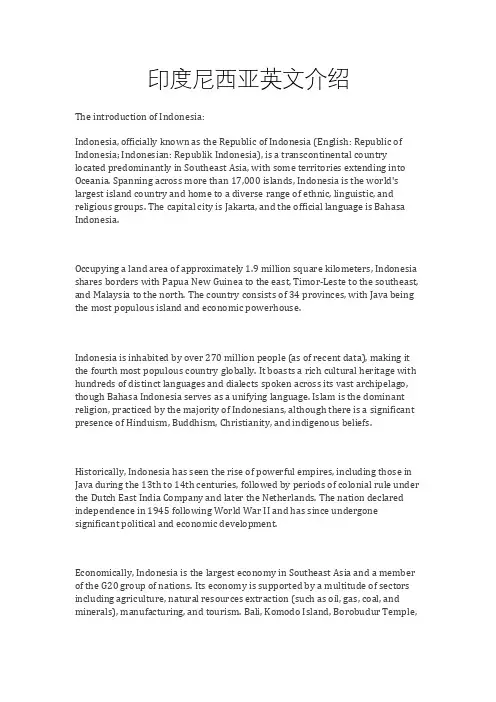
印度尼西亚英文介绍The introduction of Indonesia:Indonesia, officially known as the Republic of Indonesia (English: Republic of Indonesia; Indonesian: Republik Indonesia), is a transcontinental country located predominantly in Southeast Asia, with some territories extending into Oceania. Spanning across more than 17,000 islands, Indonesia is the world's largest island country and home to a diverse range of ethnic, linguistic, and religious groups. The capital city is Jakarta, and the official language is Bahasa Indonesia.Occupying a land area of approximately 1.9 million square kilometers, Indonesia shares borders with Papua New Guinea to the east, Timor-Leste to the southeast, and Malaysia to the north. The country consists of 34 provinces, with Java being the most populous island and economic powerhouse.Indonesia is inhabited by over 270 million people (as of recent data), making it the fourth most populous country globally. It boasts a rich cultural heritage with hundreds of distinct languages and dialects spoken across its vast archipelago, though Bahasa Indonesia serves as a unifying language. Islam is the dominant religion, practiced by the majority of Indonesians, although there is a significant presence of Hinduism, Buddhism, Christianity, and indigenous beliefs.Historically, Indonesia has seen the rise of powerful empires, including those in Java during the 13th to 14th centuries, followed by periods of colonial rule under the Dutch East India Company and later the Netherlands. The nation declared independence in 1945 following World War II and has since undergone significant political and economic development.Economically, Indonesia is the largest economy in Southeast Asia and a member of the G20 group of nations. Its economy is supported by a multitude of sectors including agriculture, natural resources extraction (such as oil, gas, coal, and minerals), manufacturing, and tourism. Bali, Komodo Island, Borobudur Temple,and Prambanan Temple are among the internationally renowned tourist destinations.In terms of ecology, Indonesia is recognized for its extensive biodiversity and contains vital ecosystems such as tropical rainforests and coral reefs. However, the country is also known for facing environmental challenges due to deforestation, climate change, and natural disasters, given its location on the Pacific Ring of Fire, which makes it prone to earthquakes and volcanic eruptions. Overall, Indonesia presents a unique blend of ancient traditions and contemporary dynamism, reflecting its multifaceted identity as a vibrant democracy and emerging market with global relevance.。
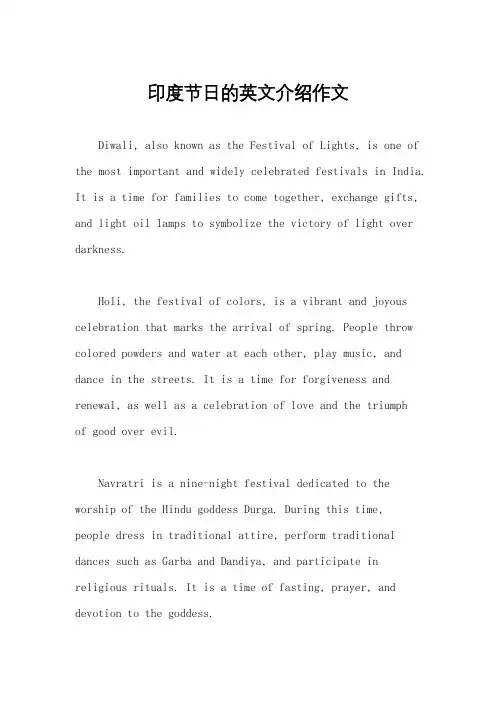
印度节日的英文介绍作文Diwali, also known as the Festival of Lights, is one of the most important and widely celebrated festivals in India. It is a time for families to come together, exchange gifts, and light oil lamps to symbolize the victory of light over darkness.Holi, the festival of colors, is a vibrant and joyous celebration that marks the arrival of spring. People throw colored powders and water at each other, play music, and dance in the streets. It is a time for forgiveness and renewal, as well as a celebration of love and the triumphof good over evil.Navratri is a nine-night festival dedicated to the worship of the Hindu goddess Durga. During this time,people dress in traditional attire, perform traditional dances such as Garba and Dandiya, and participate in religious rituals. It is a time of fasting, prayer, and devotion to the goddess.Ganesh Chaturthi is a festival that honors theelephant-headed god, Lord Ganesha. It is marked by the installation of Ganesha idols in homes and public places, as well as the offering of prayers and sweets to the deity. The festival culminates in the immersion of the idols in water, symbolizing the departure of Lord Ganesha from the earth.Raksha Bandhan is a festival that celebrates the bond between brothers and sisters. On this day, sisters tie a protective thread called a "rakhi" around their brothers' wrists, and brothers in turn promise to protect their sisters. It is a time for family gatherings, gift-giving, and the reaffirmation of sibling love and loyalty.Eid al-Fitr, also known as the "Festival of Breaking the Fast," is a significant religious holiday celebrated by Muslims in India. It marks the end of Ramadan, the Islamic holy month of fasting. On this day, people gather for prayers, exchange gifts, and share meals with family andfriends. It is a time for charity, forgiveness, and unity within the Muslim community.。
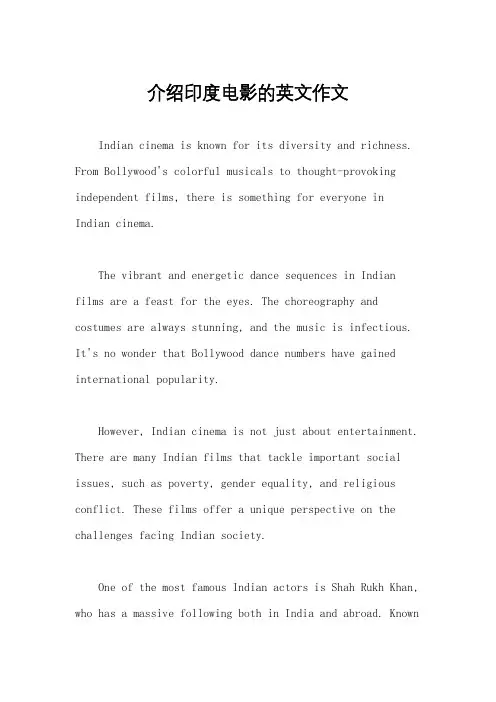
介绍印度电影的英文作文Indian cinema is known for its diversity and richness. From Bollywood's colorful musicals to thought-provoking independent films, there is something for everyone in Indian cinema.The vibrant and energetic dance sequences in Indian films are a feast for the eyes. The choreography and costumes are always stunning, and the music is infectious. It's no wonder that Bollywood dance numbers have gained international popularity.However, Indian cinema is not just about entertainment. There are many Indian films that tackle important social issues, such as poverty, gender equality, and religious conflict. These films offer a unique perspective on the challenges facing Indian society.One of the most famous Indian actors is Shah Rukh Khan, who has a massive following both in India and abroad. Knownfor his romantic roles and charismatic personality, he has become a global icon of Indian cinema.In recent years, Indian cinema has gained recognition at international film festivals, showcasing the talent and creativity of Indian filmmakers. This has helped to break down stereotypes and expand the global audience for Indian films.The future of Indian cinema looks bright, with a new generation of talented filmmakers pushing boundaries and exploring new themes. As Indian cinema continues to evolve, it will undoubtedly make an even greater impact on the global film industry.。
用英文介绍印度的风俗作文下载温馨提示:该文档是我店铺精心编制而成,希望大家下载以后,能够帮助大家解决实际的问题。
文档下载后可定制随意修改,请根据实际需要进行相应的调整和使用,谢谢!并且,本店铺为大家提供各种各样类型的实用资料,如教育随笔、日记赏析、句子摘抄、古诗大全、经典美文、话题作文、工作总结、词语解析、文案摘录、其他资料等等,如想了解不同资料格式和写法,敬请关注!Download tips: This document is carefully compiled by theeditor. I hope that after you download them,they can help yousolve practical problems. The document can be customized andmodified after downloading,please adjust and use it according toactual needs, thank you!In addition, our shop provides you with various types ofpractical materials,such as educational essays, diaryappreciation,sentence excerpts,ancient poems,classic articles,topic composition,work summary,word parsing,copyexcerpts,other materials and so on,want to know different data formats andwriting methods,please pay attention!India is a country with diverse customs and traditions. One of the most well-known customs in India is the greeting tradition. In India, people greet each other by folding their hands and saying "Namaste". This gesture is a sign of respect and is commonly used in everyday interactions.Another interesting custom in India is the practice of arranged marriages. In India, it is common for families to arrange marriages for their children. Although this tradition is becoming less common in urban areas, it isstill prevalent in many parts of the country.In India, it is customary for guests to be treated with great hospitality. When visiting someone's home, it is common for the host to offer food and drinks to their guests. This tradition reflects the importance of hospitality in Indian culture.One of the most colorful customs in India is thecelebration of festivals. India is known for its vibrant and lively festivals, such as Diwali, Holi, and Eid. During these festivals, people come together to celebrate with music, dance, and delicious food.In India, it is customary for people to remove their shoes before entering a home or a place of worship. This tradition is a sign of respect and cleanliness, and is followed by people of all religions in India.In Indian culture, it is common for people to address their elders and seniors with respect. This is often done by adding a suffix such as "ji" to their names. This tradition reflects the value placed on respect for eldersin Indian society.In conclusion, India is a country with rich and diverse customs and traditions. From the traditional greeting of "Namaste" to the celebration of colorful festivals, Indian customs reflect the values and beliefs of its people. These customs are an integral part of Indian culture and continue to be cherished and passed down through generations.。
印度风俗介绍英文作文下载温馨提示:该文档是我店铺精心编制而成,希望大家下载以后,能够帮助大家解决实际的问题。
文档下载后可定制随意修改,请根据实际需要进行相应的调整和使用,谢谢!并且,本店铺为大家提供各种各样类型的实用资料,如教育随笔、日记赏析、句子摘抄、古诗大全、经典美文、话题作文、工作总结、词语解析、文案摘录、其他资料等等,如想了解不同资料格式和写法,敬请关注!Download tips: This document is carefully compiled by theeditor. I hope that after you download them,they can help yousolve practical problems. The document can be customized andmodified after downloading,please adjust and use it according toactual needs, thank you!In addition, our shop provides you with various types ofpractical materials,such as educational essays, diaryappreciation,sentence excerpts,ancient poems,classic articles,topic composition,work summary,word parsing,copyexcerpts,other materials and so on,want to know different data formats andwriting methods,please pay attention!In India, there are numerous customs and traditionsthat are deeply rooted in its rich cultural heritage. Oneof the most fascinating aspects of Indian culture is the diverse range of customs observed by different communities across the country. These customs reflect the unique beliefs, values, and practices of the people.When it comes to weddings in India, they are not just a union of two individuals, but a grand celebration thatlasts for several days. From the colorful attire to the elaborate rituals, Indian weddings are a feast for the senses. The bride and groom are adorned in traditional attire, with the bride wearing a vibrant saree or lehenga and the groom donning a sherwani or kurta. The wedding ceremony is conducted with great pomp and show, accompanied by music, dance, and feasting.Another interesting custom in India is the celebrationof festivals. Whether it is Diwali, Holi, Eid, or Christmas,Indians celebrate all festivals with equal enthusiasm and fervor. Each festival has its own unique customs andrituals. For example, during Diwali, people light oil lamps and burst firecrackers to celebrate the victory of light over darkness. Similarly, during Holi, people play with colors and water, symbolizing the arrival of spring and the triumph of good over evil.Indian cuisine is also a reflection of its cultural diversity. From spicy curries to mouth-watering sweets, Indian food is known for its rich flavors and aromatic spices. Each region in India has its own distinct cuisine, with different ingredients and cooking techniques. Whetherit is the dosas of South India or the biryanis of North India, Indian cuisine offers a wide variety of flavors and textures that cater to every palate.In addition to weddings, festivals, and food, Indian music and dance also play a significant role in thecountry's culture. Classical dance forms like Bharatanatyam, Kathak, and Odissi are not just a form of entertainment but also a way to express emotions and tell stories. Indianmusic, with its intricate melodies and rhythmic patterns, has a soothing and therapeutic effect on the mind and soul.Lastly, the concept of hospitality is deeply ingrained in Indian culture. Guests are considered a form of God and are treated with utmost respect and warmth. It is commonfor Indian households to welcome guests with a cup of tea or a traditional sweet. The idea of "Atithi Devo Bhava," meaning "Guest is God," reflects the Indian belief in the importance of hospitality and treating others with kindness and generosity.In conclusion, Indian culture is a tapestry of customs and traditions that are as diverse as the country itself. Whether it is the grand celebrations of weddings, the vibrant festivals, the delectable cuisine, the mesmerizing music and dance, or the warm hospitality, Indian customs offer a glimpse into the rich and vibrant tapestry of this ancient civilization.。
印度风俗介绍英文作文下载温馨提示:该文档是我店铺精心编制而成,希望大家下载以后,能够帮助大家解决实际的问题。
文档下载后可定制随意修改,请根据实际需要进行相应的调整和使用,谢谢!并且,本店铺为大家提供各种各样类型的实用资料,如教育随笔、日记赏析、句子摘抄、古诗大全、经典美文、话题作文、工作总结、词语解析、文案摘录、其他资料等等,如想了解不同资料格式和写法,敬请关注!Download tips: This document is carefully compiled by theeditor. I hope that after you download them,they can help yousolve practical problems. The document can be customized andmodified after downloading,please adjust and use it according toactual needs, thank you!In addition, our shop provides you with various types ofpractical materials,such as educational essays, diaryappreciation,sentence excerpts,ancient poems,classic articles,topic composition,work summary,word parsing,copyexcerpts,other materials and so on,want to know different data formats andwriting methods,please pay attention!In India, there are a variety of customs and traditions that are deeply rooted in the culture. One of the mostwell-known customs is the practice of arranged marriages, where families play a significant role in choosing a spouse for their children.Another interesting custom in India is the use of the namaste greeting. This involves pressing the palms together in front of the chest and saying "namaste" as a sign of respect. It is a common way of greeting people, and is often accompanied by a slight bow.The festival of Diwali is a major celebration in India, and is known as the festival of lights. It is a time for families to come together, light oil lamps, and decorate their homes with colorful rangoli designs. It is also a time for giving and receiving gifts, and for enjoying traditional Indian sweets.In Indian culture, it is common for people to eat with their hands, especially when dining on traditional Indian cuisine such as curry and rice. Using the fingers to mixand eat food is considered to enhance the dining experience and is a skill that is passed down through generations.One of the most unique customs in India is the practice of yoga and meditation. These ancient practices have been a part of Indian culture for thousands of years, and are believed to promote physical and mental well-being. Many people in India incorporate yoga and meditation into their daily routines as a way to stay healthy and balanced.Overall, the customs and traditions of India arediverse and rich, reflecting the country's long and complex history. From arranged marriages to the practice of namaste, these customs are an integral part of Indian society and continue to be cherished and celebrated by people all over the world.。
印度宪法英文版The Constitution of India, adopted by the Constituent Assembly on 26th November 1949, provides the framework for the governance of the country. It is the supreme law of the land, laying down the fundamental rights, directive principles, and the structure and functions of the government. The following is a reference content of the Constitution of India in English.Preamble:"We, the people of India, having solemnly resolved to constitute India into a Sovereign Socialist Secular Democratic Republic and to secure to all its citizens:Justice, social, economic and political; Liberty of thought, expression, belief, faith and worship; Equality of status and of opportunity; and to promote among them all Fraternity assuring the dignity of the individual and the unity and integrity of the Nation" Part I: The Union and its TerritoryDefines India as a Union of States, describes the territories of India and their classification, and addresses matters related to the admission and establishment of new states.Part II: CitizenshipExplains the provisions related to Indian citizenship, such as acquisition and termination of citizenship, rights of citizenship, and the authority of Parliament in making laws on citizenship.Part III: Fundamental RightsEnshrines the fundamental rights of citizens of India, such as right to equality, right to freedom of speech, right to life and personalliberty, right to protection from discrimination, and right to constitutional remedies.Part IV: Directive Principles of State PolicyIncludes the directive principles that guide the government in making laws and policies for the welfare of the people. These principles cover a range of areas, including social justice, economic welfare, protection of the environment, and promotion of education and culture.Part IV-A: Fundamental DutiesLists the fundamental duties of citizens, which include safeguarding the sovereignty and integrity of India, promoting harmony and spirit of common brotherhood, and striving towards excellence in one's chosen field of activity.Part V: The UnionAddresses the structure and functioning of the Union government, including provisions related to the President, Vice President, Council of Ministers, and Parliament. It also deals with various aspects of legislation, money bills, and the General Budget.Part VI: The StatesDescribes the organization and functioning of the state governments, including provisions related to the Governor, Council of Ministers, and State Legislature. It also covers matters like state finance, publication of state laws, and protection of state officials.Part VII: Union TerritoriesProvides for the administration and governance of Union territories, including provisions related to the Lieutenant Governor, Administrator, and Legislative Assembly or Council, as applicable. Part VIII: The Union TerritoriesExplains the provisions related to scheduled and tribal areas, including the administration and control of scheduled areas and the protection of tribal rights and welfare.Part IX: The PanchayatsDeals with the organization, powers, and functioning of the Panchayats, which are local self-government institutions at the village, intermediate, and district levels. It includes provisions related to reservation of seats, powers and functions of Panchayats, and finances.Part IXA: The MunicipalitiesAddresses the establishment, composition, powers, and functioning of municipalities, which are local self-government institutions at the urban level. It covers matters like reservation of seats, powers and functions of municipalities, and financial provisions.Part X: The Scheduled and Tribal AreasExplains the provisions related to the administration and control of scheduled and tribal areas, including the powers and responsibilities of the Governor and legislative assembly or council, as applicable.Part XI: Relations Between the Union and the StatesOutlines the distribution of powers between the Union Governmentand the State Governments, and the mechanism for resolving disputes between them. It also covers matters like the appointment of Governors, the President's rule, and the role of inter-state councils.Part XII: Finance, Property, Contracts and SuitsAddresses matters related to finances, property, contracts, and legal proceedings. It includes provisions related to the distribution of revenues, borrowing powers, and taxation.Part XIII: Trade, Commerce, and Intercourse Within the Territory of IndiaExplains the provisions related to trade, commerce, and intercourse within India, including the powers of the Union and the States in relation to these matters.Part XIV: Services Under the Union and the StatesDeals with matters related to services under the Union and the States, including recruitment, service conditions, and the role of public service commissions.Part XIVA: TribunalsIncludes provisions related to administrative tribunals, their powers, jurisdiction, and the authority to hear disputes and grievances related to recruitment and conditions of service of persons employed in public services.Part XV: ElectionsDescribes the provisions related to elections, including the conduct of elections, appointment of Election Commission, and theallocation of seats in the Parliament and State Legislatures.Part XVI: Special Provisions Relating to Certain Classes Addresses special provisions for the advancement of socially and educationally backward classes, Scheduled Castes and Scheduled Tribes. It includes provisions related to reservation of seats, educational and economic development, and other protective measures.Part XVII: Official LanguageExplains the provisions related to the official language of the Union and the States, and the use of languages in the Supreme Court, High Courts, and for legislative purposes.Part XVIII: Emergency ProvisionsDeals with provisions related to the proclamation of emergency, including the President's rule, imposition of emergency, and suspension of fundamental rights during emergencies.Part XIX: MiscellaneousIncludes miscellaneous provisions, such as the incorporation, regulation, and winding up of corporations, anti-defection laws, inter-state river water disputes, and the validity of certain laws. Part XX: Amendment of the ConstitutionDescribes the procedures and processes for amending the Constitution, including the types of amendments, the role of Parliament and State Legislatures, and the ratification process. Part XXI: Temporary, Transitional and Special ProvisionsAddresses temporary, transitional, and special provisions, including the status of Jammu and Kashmir, and the jurisdiction and powers of the President in relation to certain matters.Part XXII: Short Title, Commencement, Authoritative Text in Hindi and RepealsSpecifies the short title of the Constitution, the date of commencement, the authoritative text of the Constitution in Hindi, and the repeal of certain enactments.In conclusion, the Constitution of India is a comprehensive and elaborate document that lays down the principles, rights, and responsibilities of the government and its citizens. It embodies the aspirations and values of the Indian people and provides a strong foundation for the democratic governance of the country.。